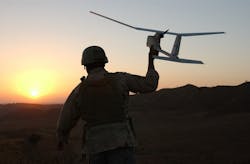New autonomous SUVs deployed in China for shuttle service
Venti Technologies deploys two autonomous SUVs in China
On Friday, June 12, safe-speed autonomous mobility company Venti Technologies announced that it successfully deployed two autonomous SUVs at a school at Nanning City, the capital of Guangxi Province, China.
The product of SAIC-GM-Wuling Automobile (SGMW), the joint venture formed by Chinese automakers SAIC and Wuling, along with GM, the SUVs provide shuttle transportation services to students and visitors. They are booked via a hailing app for destinations along a 9-station loop, and run on a 3K loop in opposite directions.
Capable of operating at a maximum speed of 15 kilometers per hour, the SUVs have been equipped with Venti Technologies’ flexible, algorithmic-based autonomous vehicle technology. Blind spots are eliminated as a result of the company’s sensor configuration, which is also capable of operating with mixed traffic and other road users such as cars, scooters and pedestrians. The vehicles can also overtake lower speed vehicles while navigating incoming vehicles from the other direction.
“The successful autonomous SUV deployment is a key milestone for Venti and showcases the breadth of opportunities for our technology,” says Xinxin Du, founder and CTO.
“Passenger vehicles require very nimble and precise operations. We are delighted to be moving forward with SGMW, a major mass volume producer of cars, microvans and other vehicles in China.”
Through Deep Learning and Model Predictive Control algorithms, Venti’s autonomous mobility platform surpasses slow, inflexible situation-based-coded systems. Vehicles equipped with Venti’s technology map as they go, and using algorithms that use abstract information constructs, they also adapt to complex environments and challenging situations.
Venti autonomous vehicles are capable of seeing small obstacles such as a 12-ounce can on the road, and around corners. The AVs do not need lane markers or beacons, can drive forwards and backwards, can do three- and five-point-turns and have state-of-the-art rain operation.
By combining the analyses to enable AVs to drive safely and reliably in complex environments, Venti’s system is the first in the world to improve both obstacle detection and vector velocity estimation accuracy, the company says.
UAS helps rescue father and daughter in California
In California, a drone was recently used to help rescue a father and daughter after their canoe capsized in the San Joaquin River. After the two were located, a member of the Antioch Police Department saved the daughter, while the Contra Costa Fire department rescued the father.
At the beginning of the video captured by the drone, a citizen in a canoe of their own is seen reaching the father and daughter, guided by the UAS. The citizen picks the daughter up and takes her back to land via their canoe while the father remains in the water staying against the sunken train ferry.
The UAS follows the canoe with the daughter in it for a few seconds before monitoring the father who is still in the water awaiting the Contra Costa Fire department to arrive in its rescue boat. The father is rescued shortly afterwards.
In a LinkedIn post, Police Sergeant Rick Smith notes that several lives are lost every year as a result of drownings in the river, making it that much more important for people to wear their life jackets when in the river.
“Recently, AntiochPD received a call of a father and daughter in the water after their canoe capsized while in the middle of the San Joaquin River. APD Ofc Shane Cole is one of 6 UAS pilots who bring their UAVs on patrol with them. He was able to rapidly deploy and located both victims in the area of an old sunken train ferry,” Smith says in the LinkedIn post, via DroneDJ.
“A citizen assisted after being shown where they were. He rescued the child in his canoe. ConFire Engine 81 dispatched their rescue boat and was able to rescue the exhausted father. The Delta claims several drowning victims every year, but not today. Reminder to always wear your life jacket.”
AeroVironment receives two orders from NSPA for its Raven and Puma 3 AE UAS
AeroVironment has received two firm-fixed-price orders totaling $9,804,448 from the NATO Support and Procurement Agency (NSPA) for its Raven and Puma 3 AE tactical UAS and spares. The first order is expected to be delivered by Aug. 2020, and the second order by Oct. 2020.
The orders are part of a three-year base contract received from NSPA in Jan. 2020. The contract includes an option for two additional years of logistics support for Raven, Wasp and Puma tactical UAS.
The total potential value of the multi-year contract is $80 million, which includes the procurement and sustainment of AeroVironment’s tactical UAS employed by the defense forces of several NATO countries.
“AeroVironment’s tactical unmanned aircraft systems, such as Raven and Puma, have helped transform the way U.S. and allied forces plan, train, equip and operate,” says Rick Pedigo, vice president of sales and business development at AeroVironment.
“Both systems benefit from continuous technology improvements and pack significant capabilities into portable, man-packable platforms that provide operators with rapid and effective force protection.”
Designed for rapid deployment and high mobility for operations requiring low-altitude intelligence, surveillance and reconnaissance, the Raven UAS has a wingspan of 4.5 feet and weighs just 4.2 pounds. Launched by hand, the UAS provides situational awareness during the day or night, with an operational range of 6.2 miles. Real-time video or infrared imagery is delivered to ground control and remote viewing stations via the Raven’s Mantis i23 EO/IR gimbaled payload.
Designed for land and maritime operations, the fully man-portable Puma 3 AE is also launched by hand. With a wingspan of 9.2 feet and weighing 15 pounds, the UAS can operate for up to 2.5 hours at a range of up to 12.4 miles with a standard antenna, and up to 37.2 miles with AeroVironment’s Long-Range Tracking Antenna (LRTA).
The all-environment Puma can land in water or on land. Its Mantis i45 EO/IR sensor suite gives the operator extended flight time and a level of imaging capability never before available in the tactical UAS class, according to AeroVironment.
AeroVironment’s family of tactical UAS use a common ground control station and software, which allows for improved interoperability and decreased training and logistics costs for NATO forces.
Compiled by Brian Sprowl, Associate Editor, AUVSI
Share your vision-related news by contacting Dennis Scimeca, Associate Editor, Vision Systems Design
SUBSCRIBE TO OUR NEWSLETTERS

